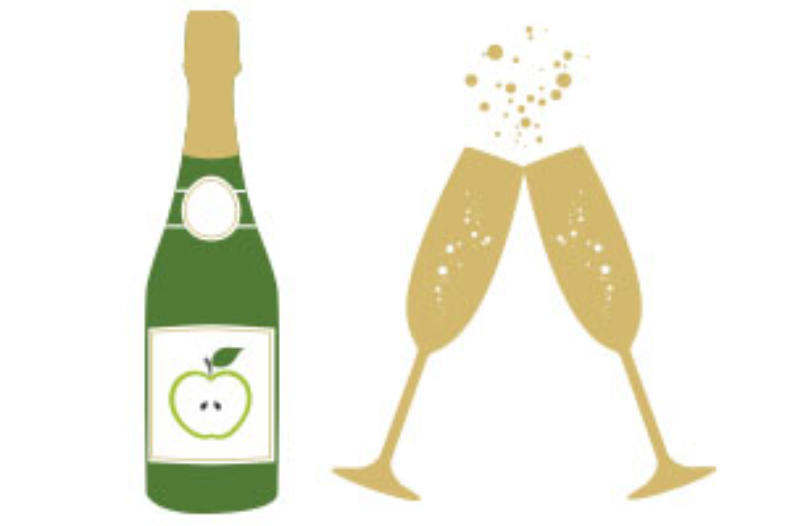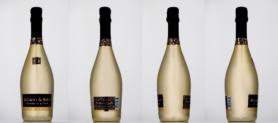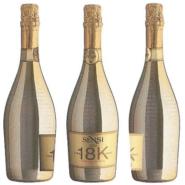Gold bottle battle
Gold bottle battle makes EUIPO position on trade mark colour clear.

This European Union Intellectual Property Office (EUIPO) decision signals that the Office does not consider the shape or indeed the colour of bottles to be distinctive – despite the Opponent’s best efforts.
On 19th December 2018, Sensi Vigne & Vini SRL (the Opponent) filed an opposition against MBG Holding GmbH’s (the Applicant) EUTM Application No. 017931837 for a 3D trade mark in classes 32 and 33 (the Opposed Application).
The opposition was based on the likelihood of confusion with the Opponent’s earlier EUTM Registration No. 016650921 for a 3D trademark in class 33 (the Earlier Registration).
A likelihood of confusion arises where there is a risk that the public might believe that goods or services of one trade mark may come from the same, or economically linked, undertaking as that of another trade mark. In order to assess the likelihood of confusion, a review of a number of factors is required:
- Similarity of the signs;
- Similarity of the goods and services;
- The distinctive character of the earlier trade mark; and
- The relevant public.
The relevant factors must be considered while bearing in mind some interdependence between them. In this regard, a lesser degree of similarity between goods may be offset by a greater degree of similarity between marks, and vice versa.
Similarity reasoning
On the issue of the similarity of goods, the Opposed Application covers goods in classes 32 (“Non-alcoholic beverages, namely non-alcoholic sparkling wine”) and 33 (“Alcoholic beverages (except beers), sparkling wine”).
However, the Earlier Registration is based on the following class 33 goods: “Wine; aperitifs; wine-based aperitifs; alcoholic aperitif bitters; liquor-based aperitifs; sparkling wines; sparkling white wines; sparkling red wines; liqueurs; potable spirits; and alcoholic beverages (except beers)”.

In terms of class 33, the EUIPO decided that the goods are identical.
As the class 32 goods of the Opposed Application would likely have the same distribution channels, consumers and producers as the class 33 goods of the Earlier Registration, and would be in competition with them, it was determined that these goods are similar.
Descriptions of marks
The Earlier Registration included the following (very lengthy) description:
"A three-dimensional trade mark consisting of the shape of wine and sparkling wine bottle, the body of which is narrower at the bottom and widens in the middle. The bottle, in mirrored, metallic gold, is characterised by figurative and word elements. On the neck of the bottle, there is a rectangular label with a yellow background and a fanciful gold frame formed by a highly stylised representation of various yellow leaves. Superimposed on the aforesaid shape, there is a circular shape with a yellow background and a gold frame, inside of which there is the text “18K SENSI FAMILY OF WINEMAKERS SINCE” in fanciful letters, placed on three lines. The text “18K” appears in gold, the text “FAMILY OF WINEMAKERS SINCE” appears in gold and overlaps the number “1890”, likewise in gold, while the text “SENSI” appears in black with a gold outline, and underneath there is a stylised leaf in gold. At the bottom of the bottle, there is a rectangular label in yellow with a fanciful gold frame formed by a highly stylised representation of various yellow leaves. The label contains the following text, all in fanciful letters: “SENSI” in black with a gold outline, “FAMILY OF WINEMAKERS SINCE” in gold overlapping the number “190”, likewise in gold, “PURE 18K GOLD” in gold and “PRODOTTO IN ITALIA” in red".
The Opposed Application did not include a description (this is not a compulsory requirement). However, the EUIPO provided the below description within the decision:
"The contested trade mark has a black film on the neck of the bottle, including in gold neoplasms, stylised. Once again, there is a logo with the word “SCAVI”, a stylised letter S and a crown. Once again, the word “SCAVI” and the word “Ray” are depicted on the bottle’s top label on the top, connected with a stylised commercial “&”. Furthermore, the word sequence “MOMENTO D’ORO” is located underneath. At the bottom end of the label, the word “SPUMANTE” is represented in simple block lettering with a comparatively large distance between the individual letters".
Aural, visual and conceptual similarity
As some of the words of both marks are devoid of distinctive character, and given that these elements differ from one another completely, the EUIPO did not feel it necessary to provide a detailed assessment of the individual components.
The marks differ in terms of the packaging, labels and different word components. While there are similar components in relation to the shape and colour of the bottles, these are non-distinctive.
Therefore, when considering the marks in their totalities, they are, at best, visually similar.
All the words can be distinguished from one another and therefore the marks are aurally dissimilar.
In the best-case scenario, the conceptual comparison is neutral due to the non-distinctive elements of the marks.
Similarity of shape and colour
Crucially, the Opponent based the opposition on the similarity between the shapes of the bottles and the gold colour.

The Earlier Registration: EUTM Registration No. 016650921
The EUIPO was quick to state that the two bottle shapes would be perceived by the relevant public as being common storage containers for the goods applied for/protected. The shape of the bottle of wine was therefore considered non-distinctive and irrelevant when assessing a likelihood of confusion.
"The EUIPO found that the colour gold has developed as an accolade of goods and is not distinctive".
It is worth noting that the Earlier Registration was registered on the basis of the overall components in the mark and not because of the perceived distinctiveness of the shape or colour. The scope of the mark’s protection is therefore limited to the distinctive elements, namely the labelling and word elements, which differ significantly from those of the Opposed Application in this case.
The opposition therefore failed, and the Applicant was awarded costs.
Appeal unlikely
The Opponent has until 11th January 2020 to appeal, but the EUIPO has made it clear that it does not consider the shape or colour of the bottles of wine to be distinctive.
A quick Google search for “gold wine bottles” brings up many gold bottles from a variety of proprietors, indicating that the EUIPO’s finding may indeed be correct. And given that the remainder of the visual and phonetic elements are clearly distinguishable, this decision may be difficult to overturn.
Note: The original decision was issued in German.
Key points:
- When applying for registration of a trade mark, consider which elements are likely to be found distinctive – they may not be the elements you want to be when subjected to EUIPO examination.
- Seek advice on how to make particular elements distinctive (for instance through intensive use) where possible.
Charlotte Wilding is a Chartered Trade Mark Attorney and Of Counsel, Head of Trade Marks at Kemp Little LLP
Read more case comments
Dig deep to protect your rights
Legal dangers may lurk in online portals, as an Italian potato grower discovered, writes Nicola Ivey. C-426/24 P, Romagnoli Fratelli SpA v Community Plant Variety Office, CJEU.
Brought to heel
The EUIPO upheld Dr Martens’ position marks in a pair of cases, writes Edward Watt. 000066484/000066396, Mtng Europe Experience, SLU v Airwair International Ltd, EUIPO Cancellation Division.
Don't lose count
Much is at stake if a company fails to file its claim in reasonable time, writes Eleni Mezulanik. C-452/24, Lunapark Scandinavia Oy Ltd v Hardeco Finland Oy, CJEU.
Beyond borders
Deniz Toker on cross-border IP: when stocking in Spain becomes infringement in Germany. C-76/24, Tradeinn Retail Services SL v PH, CJEU.
Hitting the right note
A jingle judged unsuitable for a sound mark finally resonated when it went to appeal, writes Sarah Brooks. T-288/24, Berliner Verkehrsbetriebe v EUIPO, General Court.
Counting the cost
This judgment provides useful guidance on quantifying damages in trade mark infringement cases, writes Richard May. [2025] EWHC 2376 (Ch), Merck KGaA v Merck Sharp & Dohme LLC & Ors.








